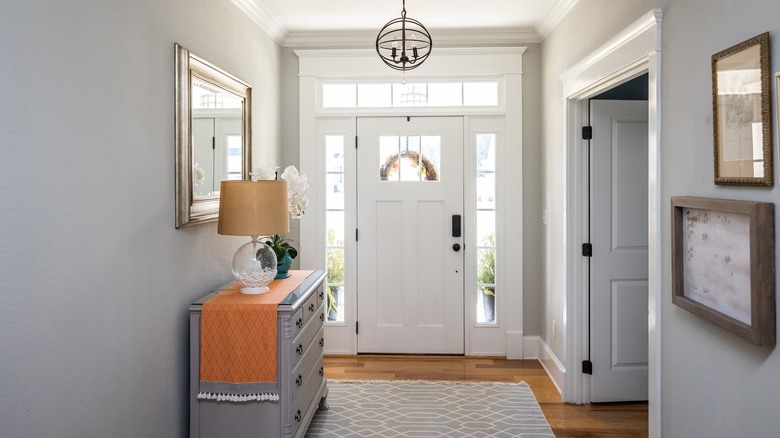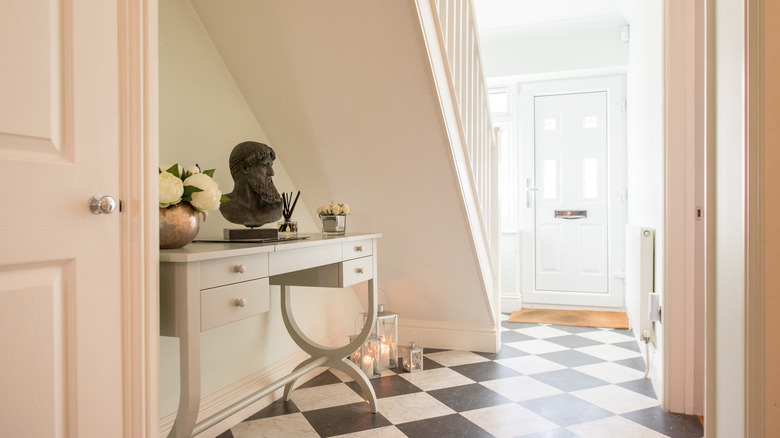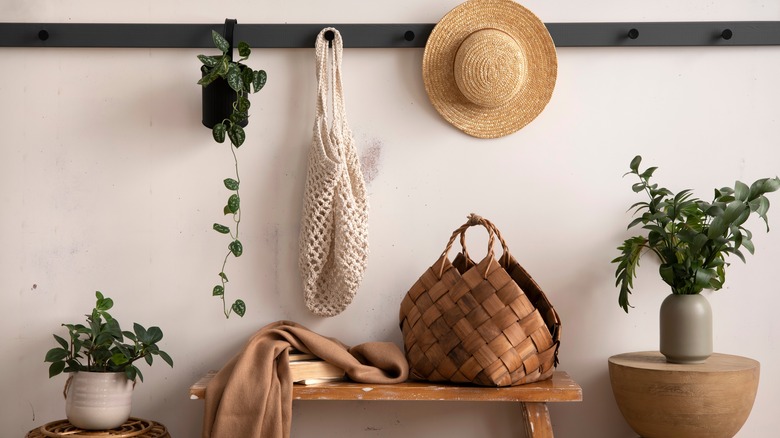Erin Napier's Book Reveals What An Entryway Should Be
We may receive a commission on purchases made from links.
When it comes to creating a charming home, Erin Napier is the expert. The interior designer and her husband Ben star in HGTV's "Home Town," where they revitalize homes while maintaining some of the original character. Her signature style, which features antique and "grandmillenial" elements, is what draws fans to Napier's designs. The finished homes always look welcoming and cozy. When designing the entryway, Napier believes homeowners should put in lots of effort to make it reflect their personal tastes. "The entry sets the agenda of a home: it tells visitors what they can expect as they proceed farther in," Napier writes in her book "Heirloom Rooms: Soulful Stories of Home," which can be purchased on Amazon.
In fact, the entryway was the first room that she and her husband tackled when they moved into their own home. Their foyer contains items that characterize those who are living in the space. This first room in the house is like the appetizer to the rest of the style, giving a sneak peek in just a few small square feet. But it's also where items, both intentionally placed and accidentally left, tend to reside. These items give a unique view into the lives of the homeowners. Because of this, entryways should be both intentionally designed and authentically lived in.
The Napier's entryway
In Erin and Ben Napier's home in Laurel, Mississippi, the entryway is somewhat of a unique room. The majority of the walls in the home are white, but the spaces between rooms, including the foyer, have color to make them feel more comfortable and welcoming. The decor of the room also sets the entryway apart from the rest of the home. "You won't find photos of [Ben] and me because our walls are covered with the people we love," Napier writes in an Instagram caption of a photo of her foyer. "Our people were young and silly and adventurous, they shaped who we are and what we become, and their presence everywhere we turn makes home feel the way it should — the most comfortable place where we can be ourselves."
Beyond the collection of photos, the Napier's entryway also has a bench against the wall with a collection of eclectic pillows where their children can slip their shoes on and off. Further, the wall hooks hold a collection of tote bags. Both these elements make the space more functional while still fitting with Napier's distinct style. And, the screen doors were made by Ben's company, Scotsman Co., another personal touch. The style of the room provides a glimpse into what the rest of the home will look like: an updated interior that features the original charm of the house's architecture.
Let the entryway introduce the style
As Erin Napier says, the entryway should tell you what to expect in the rest of the home. Think of it as a first impression or a hint that gives you a glimpse of what the other rooms may look like. However, this doesn't mean that the entryway needs to mirror the living room or kitchen exactly. In fact, it's more interesting if it doesn't, as even Napier mentions that her foyer is a different color than the other rooms in her home. Break down the elements of your style and identify which can run from one room to the next. It may be the molding and trim, the flooring that flows from one space to the other, or one common material like natural wood or glass.
Of course, you can also introduce the home's style through the small details. Consider using art, decorative objects, mirrors, and table lamps to create a curated look in the entryway. These details don't have to match each other exactly but should rather simply have the same overall aesthetic. Also, consider the feeling you want your home to have and choose elements that match. For example, a floral-patterned wallpaper can work for traditional homes, while something bright, bold, and abstract may work more for a modern maximalist. Working within one design profile in every room is a simple way to unify the entire home.
Make it functional while still being authentic
Along with the aesthetic of the entryway, the space should also be functional. One of the easiest places to start is with a bench. In the Napier's entryway, there is a wooden bench with space underneath for storage. Having a bench in the entryway allows you to sit down, put on or take off your shoes, or wait for someone when leaving the house. Storage is also a must-have in every foyer. If you don't wear shoes in your home, having a shoe rack or basket to corral them all in is essential. Otherwise, you'll have a bunch of shoes scattered on the floor, making the entryway look cluttered and creating a tripping hazard. Similarly, consider storage for coats if you don't have a coat closet. Use wall hooks or a coat rack to hang your outerwear.
However, while all of this is crucial, also keep in mind that the entryway should look authentic to your family's lifestyle. In the Napier's entryway, bags are hung, pictures line the walls, and rain boots sit by the door. While some may desire to hide these 'messy' items, Erin Napier says that they should be put on display, as they're what makes the space truly feel like a home. They provide guests with an authentic look into your everyday life. Therefore, while storage can reduce some clutter, don't be afraid to leave some bags and shoes out in the open.


